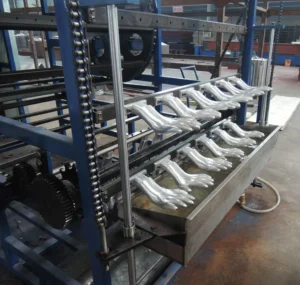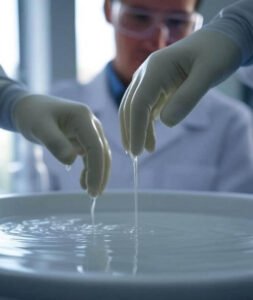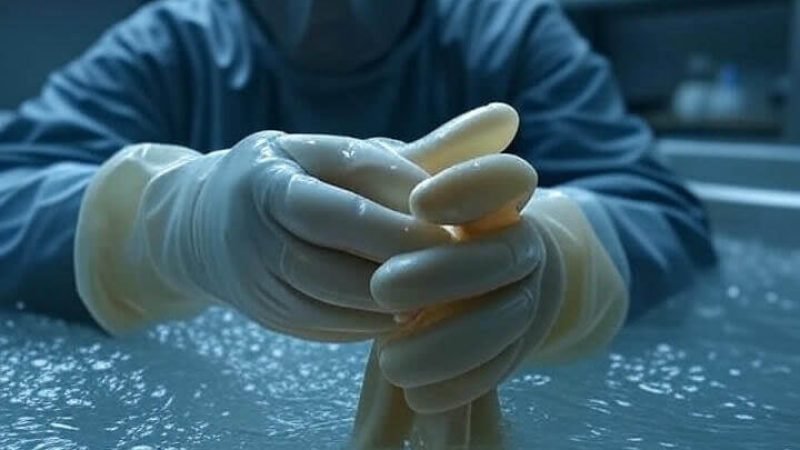What is the Process of Dipping Gloves?
Table of Contents
Introduction to Glove Dipping
Glove dipping is a specialized manufacturing process used to produce protective gloves by coating hand-shaped forms (called formers or molds) with liquid materials such as latex, nitrile, vinyl, or other synthetic polymers. This process creates seamless, flexible gloves that provide protection against chemicals, biological hazards, and physical contaminants across various industries including healthcare, food processing, automotive, and chemical manufacturing.
The glove dipping process has evolved significantly since its inception in the early 20th century, transforming from manual operations to highly automated systems that can produce millions of gloves daily. Modern glove dipping machines incorporate advanced technology to ensure consistent quality, precise thickness control, and efficient production rates while maintaining strict hygiene and safety standards.
Overview of the Glove Dipping Process
The glove dipping process involves several critical stages that transform liquid polymer compounds into finished protective gloves. The entire process typically takes place in a controlled environment where temperature, humidity, and cleanliness are carefully monitored to ensure optimal product quality.
At its core, the process involves dipping aluminum or ceramic hand-shaped forms into tanks containing liquid polymer solutions. These forms, heated to specific temperatures, cause the liquid material to adhere and form a thin film that eventually becomes the glove wall. The thickness of the final product depends on factors such as dipping speed, solution concentration, temperature, and dwell time in the coagulant and polymer baths.

Essential Equipment and Materials
Glove Dipping Machine Components
A modern glove dipping machine consists of several integrated systems working in harmony to produce high-quality gloves. The primary components include the former chain system, which carries hundreds or thousands of aluminum hand forms through various processing stations. These formers are precisely engineered to replicate human hand dimensions and are heated to temperatures ranging from 80°C to 120°C depending on the polymer type being used.
Key Components of a Glove Dipping Machine:
- Former chain conveyor system
- Heating ovens for former preheating
- Coagulant dip tanks
- Polymer compound tanks with agitation systems
- Leaching and washing stations
- Vulcanizing or curing ovens
- Cooling zones
- Powder application systems (if required)
- Stripping stations
The machine’s control system manages critical parameters such as line speed, tank temperatures, dwell times, and chemical concentrations. Advanced glove dipping machines feature computerized controls that allow operators to adjust these parameters for different glove specifications and maintain consistent quality throughout production runs.
Materials and Chemicals
The choice of materials significantly impacts the final glove properties, including chemical resistance, durability, tactile sensitivity, and allergenic potential. Natural rubber latex remains popular for its excellent elasticity and barrier properties, while synthetic alternatives like nitrile offer superior chemical resistance and are suitable for latex-allergic individuals.
Coagulants, typically calcium nitrate or calcium chloride solutions, play a crucial role in the dipping process by causing the polymer to gel and adhere to the heated formers. The concentration and temperature of coagulant solutions directly affect the glove’s physical properties and must be carefully controlled throughout production.
Step-by-Step Glove Dipping Process
Preparation Phase
The glove dipping process begins with thorough preparation of the aluminum formers, which must be meticulously cleaned to remove any residual materials from previous production runs. The formers are then heated in specialized ovens to the optimal temperature for the specific polymer being used. This preheating step is critical as it determines how the liquid polymer will behave when it contacts the former surface.
Preparation Steps:
Clean formers undergo rigorous washing and inspection before entering the heating zone. The glove dipping machine automatically monitors former temperatures using infrared sensors to ensure consistency. Any formers not meeting temperature specifications are automatically rejected or recycled through the heating process.
Dipping Stages
The actual dipping process involves multiple immersion stages, each serving a specific purpose in building the glove structure. The first dip typically involves a coagulant solution that prepares the former surface for polymer adhesion. The heated formers are lowered into the coagulant tank at a controlled speed, with dwell time carefully calculated to achieve optimal surface preparation.
Following coagulant treatment, the formers proceed to the main polymer dip tank. Here, the glove dipping machine controls the immersion speed, depth, and withdrawal rate to achieve the desired glove thickness. Some applications require multiple polymer dips to build up adequate wall thickness or to create multi-layer structures with different properties.
Curing and Finishing
After the dipping stages, the gloves undergo curing or vulcanization in high-temperature ovens. This process cross-links the polymer chains, giving the gloves their final strength, elasticity, and chemical resistance properties. Curing temperatures typically range from 100°C to 130°C, with precise time and temperature profiles depending on the polymer formulation.
Post-curing processes may include leaching to remove residual chemicals, washing to ensure cleanliness, and optional powder application for easier donning. The glove dipping machine incorporates automated systems for each of these finishing steps, ensuring consistent treatment of every glove produced.

Quality Control and Testing
Quality control is integrated throughout the glove dipping process, with automated inspection systems checking for defects such as holes, thin spots, or contamination. Modern glove dipping machines employ various testing methods including air inflation tests, electrical conductivity tests, and visual inspection systems using high-resolution cameras and artificial intelligence algorithms.
Batch testing protocols ensure that finished gloves meet regulatory requirements for their intended applications. This includes testing for physical properties like tensile strength and elongation, as well as specific performance criteria such as viral barrier effectiveness for medical gloves or chemical permeation resistance for industrial applications.
Applications and Industries
Gloves produced through the dipping process serve critical roles across numerous industries. In healthcare settings, examination and surgical gloves provide essential barrier protection against bloodborne pathogens and cross-contamination. The food processing industry relies on food-grade gloves to maintain hygiene standards while protecting workers from cleaning chemicals and temperature extremes.
Industrial applications include chemical handling, automotive assembly, electronics manufacturing, and laboratory work. Each application may require specific glove formulations and properties, which modern glove dipping machines can accommodate through programmable parameter controls and quick changeover capabilities.
Conclusion
The glove dipping process represents a sophisticated manufacturing technique that combines chemistry, engineering, and quality control to produce essential protective equipment. Modern glove dipping machines have revolutionized this industry by enabling high-volume production while maintaining strict quality standards and regulatory compliance.
As industries continue to prioritize worker safety and hygiene, the demand for high-quality dipped gloves continues to grow. Advances in polymer chemistry, automation technology, and quality control systems ensure that the glove dipping process will continue to evolve, producing increasingly sophisticated protective products to meet emerging challenges in healthcare, food safety, and industrial protection.
Understanding the intricacies of the glove dipping process is essential for manufacturers, quality managers, and procurement professionals who rely on these critical protective products. The investment in advanced glove dipping machine technology and rigorous process control ultimately translates into safer working environments and better protection for end users across all industries
